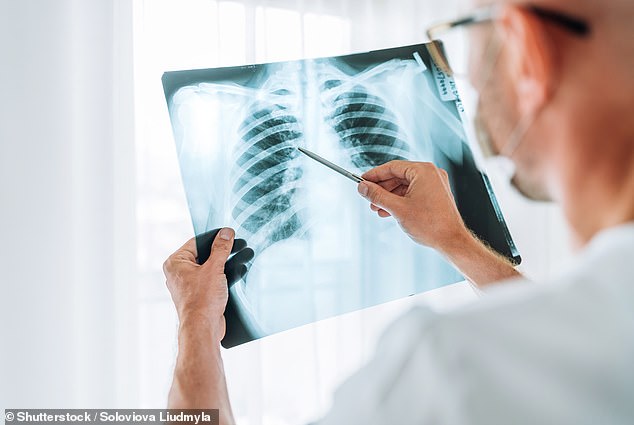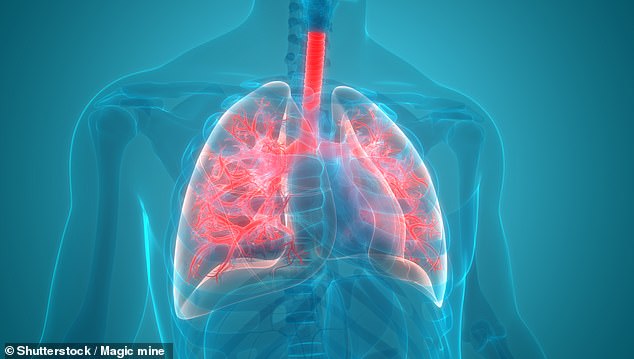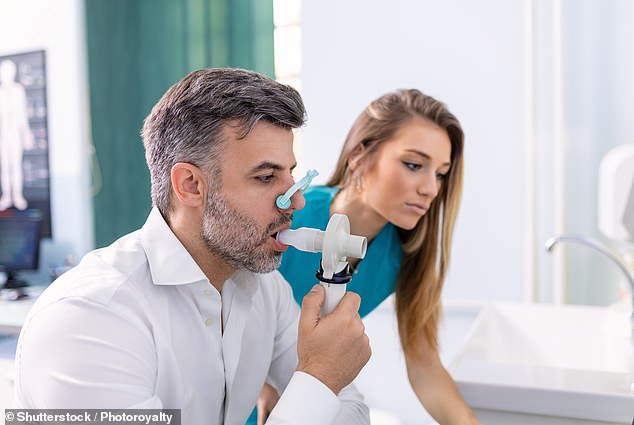An ultrasensitive breath test could detect lung cancer by analyzing chemical changes in the air we exhale, a study suggests.
Researchers have developed small sensors that can distinguish key changes in the breathing of people with the disease.
It has already been established that a decrease in an exhaled chemical, isoprene, may indicate the presence of lung cancer.
However, to detect such small changes, a sensor would have to be very sensitive and capable of detecting isoprene levels in the parts per billion range.
The team, from Zhejiang University Polytechnic Institute in China, built on previous attempts and developed small “nanoflake” sensors containing platinum, indium and nickel.
In the UK, around 35,000 people die from lung cancer each year (file image)

Lung cancer has one of the lowest survival rates of all cancers, which is largely attributed to lung cancer being diagnosed at a late stage (file image)
Tests showed that the sensor responded to isoprene more than any other chemical commonly found in breath, and was able to detect isoprene levels as low as 2 parts per billion, a sensitivity that far exceeded previous sensors. .
To test the device, they exposed it to the breath previously collected from 13 people, five of whom had lung cancer.
The device successfully detected isoprene levels below 40 parts per billion in samples from participants with cancer and more than 60 parts per billion from participants without cancer.
This screening technology could provide a breakthrough in non-invasive lung cancer detection and has the potential to improve outcomes and even save lives, the researchers said.
In an article published in the journal American Chemical Society Sensors, they state: “This study presents a novel nanoflake isoprene sensor that achieves an exceptionally low detection limit of 2 parts per billion, the lowest recorded to date for sensors.” of isoprene.
«In particular, it has a high selectivity and a notable anti-humidity capacity, which is why it meets the strict requirements for the detection of lung cancer.
“Our work not only provides a breakthrough in low-cost, non-invasive cancer detection using breath analysis, but also promotes the rational design of next-generation gas detection materials.”
In the UK, around 35,000 people die from lung cancer each year.

Researchers have developed small sensors that can distinguish key changes in the breathing of people with the disease (File image)

This detection technology could represent a breakthrough in the non-invasive detection of lung cancer
It has one of the lowest survival rates of all cancers, which is largely attributed to lung cancer being diagnosed at a late stage, when treatment is much less likely to be effective.
Early cancer treatment improves people’s chances of survival: 60 percent of people currently survive stage 1 cancer for 5 years or more and 4 percent survive stage 4 cancer.
Last year, the government announced it was rolling out lung cancer screening for people aged 55 to 74 with a history of smoking in a bid to detect cancer earlier and speed up diagnosis.
Current tests may include a chest x-ray, CT scan, and positron emission tomography (PET-CT).


